US equity futures are poised to open lower on Monday, extending Friday’s slide into this data-heavy week after pulling back from all-time highs at the end of last week, with technology shares leading declines in the wake of data giving mixed signals about the strength of the job market. Ahead of tomorrow’s CPI print, S&P futures were down 0.2% at 7:50am, but off the worst levels of the session.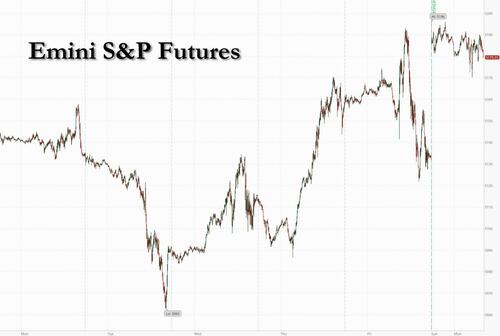 Nasdaq futures dropped 0.3% with Nvidia fluctuating wildly in the pre-market after its huge 10% intraday reversal on Friday, which followed a weaker than expected jobs report (and actually quite catastrophic NFP print if one actually reads the details).
Nasdaq futures dropped 0.3% with Nvidia fluctuating wildly in the pre-market after its huge 10% intraday reversal on Friday, which followed a weaker than expected jobs report (and actually quite catastrophic NFP print if one actually reads the details).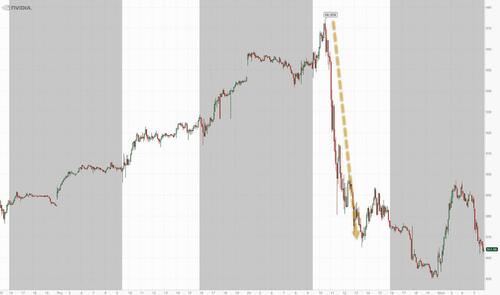 The overnight session also saw the Nikkei 225 tumble 2.2%, and the drop was far worse earlier before a sharp ramp in the last 30 minutes of trading, as growing speculation the Bank of Japan will end Yield Curve Control and/or raise interest rates lifted the yen and hurt exporters
The overnight session also saw the Nikkei 225 tumble 2.2%, and the drop was far worse earlier before a sharp ramp in the last 30 minutes of trading, as growing speculation the Bank of Japan will end Yield Curve Control and/or raise interest rates lifted the yen and hurt exporters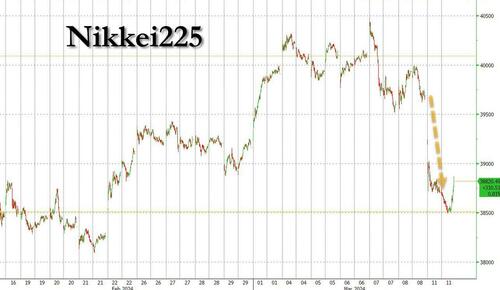 Bitcoin briefly topped $72,000 for the first time, advancing for a sixth straight day and taking this year’s rally to almost 70% on the back of massive inflows into US exchange-traded funds; a tacit endorsement by Donald Trump who will be the next president in November, also helped push the crypto currency higher
Bitcoin briefly topped $72,000 for the first time, advancing for a sixth straight day and taking this year’s rally to almost 70% on the back of massive inflows into US exchange-traded funds; a tacit endorsement by Donald Trump who will be the next president in November, also helped push the crypto currency higher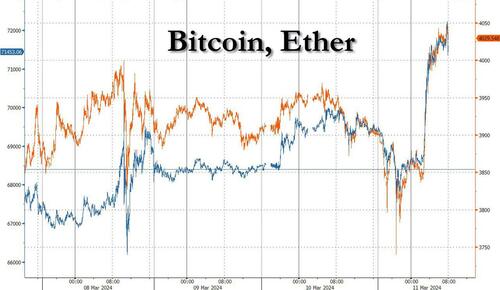 Elsewhere, bond yields were mixed with 10Y yield rising 1bp to 4.08%; the USD is flat following its worst performing week of the year. Commodities are mixed with strength in Energy but weakness in Ags/Metals; base metals are underperforming precious metals with iron ore plunging 7%. CPI is the macro focus this week but there are several bond auctions to watch esp. with the potential for BOJ to tweak YCC/ZIRP next week.In premarket trading, cryptocurrency-linked companies rally as Bitcoin extends gains to an all-time high, surpassing the $71,000 mark. Among movers Coinbase Global (COIN) +7.2%, Riot Platforms (RIOT) +5.7%. Boeing dropped 1.4% after a weekend of negative headlines, which included the DOJ opening a criminal investigation into the incident on an Alaska Airlines-operated 737 Max 9 jet in January, and also another mid-air incident, this time involving a Boeing 787. Here are some other notable premarket movers.
Elsewhere, bond yields were mixed with 10Y yield rising 1bp to 4.08%; the USD is flat following its worst performing week of the year. Commodities are mixed with strength in Energy but weakness in Ags/Metals; base metals are underperforming precious metals with iron ore plunging 7%. CPI is the macro focus this week but there are several bond auctions to watch esp. with the potential for BOJ to tweak YCC/ZIRP next week.In premarket trading, cryptocurrency-linked companies rally as Bitcoin extends gains to an all-time high, surpassing the $71,000 mark. Among movers Coinbase Global (COIN) +7.2%, Riot Platforms (RIOT) +5.7%. Boeing dropped 1.4% after a weekend of negative headlines, which included the DOJ opening a criminal investigation into the incident on an Alaska Airlines-operated 737 Max 9 jet in January, and also another mid-air incident, this time involving a Boeing 787. Here are some other notable premarket movers.
Looking at this week’s main economic event, Tuesday’s CPI report, BBG calls it “a key piece of the puzzle” toward completing the backdrop for the Fed to start cutting rates in the middle of the year. While comments from policy makers last week appeared very dovish, and swaps traders see a June rate cut as a virtual lock, a stronger-than-anticipated jump in consumer prices could derail rallies in stocks and bonds fueled by confidence that the Fed is on the verge of pulling inflation back to its target. That was the case last month, when the CPI data triggered a market selloff. The impact may be stronger this time because it’s the last major piece of economic data before the Fed’s March 20 meeting.“The bottom line is that loads of folk are preoccupied trying to predict or front-run a first Fed rate cut,” said Mark Dowding, the CIO at RBC BlueBay Asset Management. “I still see this as some months away.”Further moderation in US prices would support the disinflation narrative that broadly remains intact, despite a pullback in the number of Fed rate cuts expected this year. Core prices in the consumer price index are expected to tick 0.3% higher in February from a month earlier, and 3.7% on a year-over-year basis — which would be the smallest annual rise since April 2021. Recent comments from policy makers have supported the case for easing. The S&P 500 rallied 1% Thursday when Powell said in his testimony before the Senate that the central bank is “not far” from being ready to cut interest rates. The same day, Powell’s European counterpart Christine Lagarde said the European Central Bank could start reducing rates as soon as June, sending the Stoxx Europe 600 Index up 1.3%.“A lack of a second-half growth inflection could serve as a headwind for economically sensitive areas of the market, particularly if the Fed holds off on cutting rates longer than expected,” according to Morgan Stanley’s chief US equity strategist Michael Wilson, one of the most prominent bearish voices on Wall Street. His 2024 target for the S&P 500 is 4,500, implying a roughly 12% drop from Friday’s close.European stocks fell for the first time in four sessions, with the Stoxx 600 down 0.6% as basic resources led declines after iron ore slumped on slackening demand from China. Tech stocks are also underperforming, as they did on Wall Street on Friday. Here are the biggest movers Monday:
Earlier in the session, Asian stocks fell for the first time in four days, dragged lower by a pullback in high-flying semi shares and a selloff in Japanese equities. The MSCI Asia Pacific Index declined as much as 1.2% and was headed for its biggest drop since Jan. 17. The region’s chip stocks, which rallied alongside US peers last week on optimism that generative artificial intelligence will boost demand, slumped on Monday after worries over lofty valuations triggered Nvidia Corp.’s worst slump since May. TSMC was the biggest drag on the Asian benchmark, followed by Japan’s Toyota.The Nikkei 225 Index lost more than 2% and slumped below 39,000 as growing speculation the Bank of Japan will raise interest rates boosted the yen and hurt exporter shares. Stocks in Hong Kong and China bucked the broad regional downtrend after data on Saturday showed Chinese consumer prices rose for the first time since August, easing some concerns over deflation. Bilibili led a rally in tech stocks in Hong Kong after JPMorgan upgraded the stock on strong guidance.In FX, the Bloomberg Dollar Spot Index slipped 0.1%, extending losses into a seventh day, its longest losing streak in almost four years. The yen tops the G-10 FX pile, rising 0.3% versus the greenback as speculation swirls around the Bank of Japan meeting next week – the BOJ did refrain from ETF buying today even after the Topix fell 2.3% by midday local time.In rates, treasuries are narrowly mixed with front-end of the curve underperforming slightly; 2-year yields cheaper by around 2bp on the day. US 10-year yields around 4.08%, marginally cheaper on the day with bunds lagging by around 0.5bp and gilts outperforming by 1.5bp in the sector; front-end underperformance in the US flattens 2s10s spread by 1.2bp on the day and 5s30s by 1.5bp. Moves across core European rates also muted, with bunds marginally flatter. The US session includes a wave of supply, with heavy corporate issuance expected alongside an auction of 3-year Treasury notes. Tuesday brings CPI data, and 10- and 30-year debt auctions are slated for the first half of this week. US auctions kick-off at 1pm New York with $56b 3-year note sale, followed by $10b 10-year and $22b 30-year on Tuesday and Wednesday, respectively. In commodities, oil held a loss ahead of reports from OPEC and the IEA this week that may provide clues on the demand outlook. WTI traded near $78. Spot gold is also little changed around $2,178/oz, trading at an all time high.In crypto, Bitcoin briefly topped $72,000 for the first time, advancing for a sixth straight day and taking this year’s rally to almost 70% on the back of massive inflows into US exchange-traded funds; a tacit endorsement by Donald Trump who will be the next president in November, also helped push the crypto currency higher; Ethereum soared past 4k and is also approaching its all time high. LSE said it will accept applications for the admission of Bitcoin (BTC) and Ethereum (ETH) crypto ETNs in Q2 2024. Indian cryptocurrency investment platform Mudrex is now offering US spot-Bitcoin (BTC) exchange-traded funds (ETFs) to Indian investors, according to CoinDesk.On the economic data calendar today we have the February New York Fed 1-year inflation expectations; main events this week includes CPI, retail sales, PPI, Empire manufacturing, industrial production and University of Michigan sentiment. No scheduled Fed speakers due before March 20 policy decisionMarket Snapshot
Top Overnight News
A more detailed look at global markets courtesy of NewsquawkAPAC stocks traded with a downbeat mood with most major indices pressured after Friday’s tech-led declines in the US, while participants also digested last week’s hawkish BoJ source reports and Japanese GDP. ASX 200 slumped in which the mining and resources industries led the declines across all sectors. Nikkei 225 fell beneath the 39,000 level following recent source reports that suggested a potential exit from NIRP this month and after Japan’s revised Q4 GDP data missed expectations but showed the economy averted a technical recession. Hang Seng and Shanghai Comp. bucked the trend with the former boosted by tech strength and with Hong Kong’s top market regulator seeking an expansion of the Stock Connect and lower the asset threshold for mainland China investors to CNY 100k. Conversely, the mainland was much less decisive after mixed Chinese inflation data which showed a return to acceleration in consumer prices.Top Asian News
European bourses, Stoxx600 (-0.4%), are entirely in the red, with the Eurostoxx50 (-0.7%) hampered by significant losses in chip-maker ASML (-3.3%). European sectors hold a strong negative tilt; Real Estate is propped up by Leg Immobilien (+5.5%), post-earnings; Tech is weighed on by negative sentiment permeating within the semi-conductor industry. US equity futures (ES -0.1%, NQ -0.1%, RTY +0.1%) are mixed and are trading on either side of the unchanged mark; earlier, the NQ posted heftier losses, hampered by Nvidia (+1.6% pre-market), which was initially lower by as much as 2% in the pre-market, though has since reversed course. Newsflow around NVDA includes a lawsuit regarding NeMo AI and a WSJ profile article.Top European News
FX
Fixed Income
Commodities
Geopolitics: Middle East
Geopolitics: Other
US Event Calendar
DB’s Jim Reid concludes the overnight wrapA very good late afternoon from a hot Sydney where it’s been nice to be back after a decade, even if the trip has caused havoc with my body clock. I’d also forgotten how crushingly mind-numbing a 24-hour flight is. However, this weekend the alternative was a sleepover at home for five so I still may have been dealt the better hand.Last night, I published a new chartbook that I thoroughly enjoyed researching with my team, entitled “Geopolitics: 2000 years of long-term charts”. The pack shows how the global geopolitical situation got to where it is today in the form of long-term charts and maps. It also tries to understand the likely paths going forward. Geopolitics is heavily linked to the changing nature of economic, military and demographic power across the world. These tectonic plates can grind against each other for years or decades, before shifting dramatically and causing a major upheaval in the global balance of power. Perhaps the biggest lesson from the pack and from history is that in the world of geopolitics and international relations, there are few permanent fixtures, only constant change. See the pack here.In 2000 years I’m not sure if $250bn has ever been wiped off a stock in 3 hours before. That’s what happened to Nvidia on Friday as the stock went from being around +5% up to -6.5% down intraday before closing -5.55%. Then in after-hours trading on Friday, it was down almost another -3%. Remarkably it was still up +6.38% on the week, +21.3% in March so far, and has still posted a tenth week of consecutive gains. That said, the sell-off late in the week meant the S&P 500 (-0.65% Friday) was down -0.26% for the week, and just missed out on advancing for 17 of 19 weeks for the first time since 1964. The macro world is still in hock to the Mag-7 so keep an eye out for what happens next, but this week the macro world will have its own things to focus on with US CPI tomorrow.On that, with 10yr US yields around -10bps lower, and the S&P 500 around +2% higher than where they were just before last month’s higher-than-expected CPI, it’s fair to say that markets have shrugged off this upside print alongside the high PPI and core PCE prints that followed. Before we preview the US CPI (tomorrow) and PPI (Thursday), the other main US highlights are the NY Fed 1-yr inflation expectations survey (today), retail sales (Thursday) and UoM consumer sentiment (Friday). There are also 3-, 10- and 30-yr UST auctions today through Wednesday.In Europe, the monthly UK GDP for January on Wednesday and labour market indicators tomorrow come a week before the next BoE meeting. In Asia, we have China’s 1-yr MLF rate where our economists think we will see a 15bps cut. In Japan, the 1st survey results from the important shunto wage negotiations will be released on Friday, which will be key ahead of the BoJ meeting a week tomorrow where speculation mounts that negative rates will end. These are the main highlights but see the full week ahead at the end for all the week’s key global events.Now expanding on the main event. With gas prices up around 4.1% from January, our economists expect headline CPI (+0.41% forecast, consensus +0.4%, vs. +0.31% previously) to grow faster than core (+0.30%, consensus +0.3%, vs. +0.39% previously). This would bring YoY core CPI two-tenths lower to 3.7%, with headline flat at 3.1%. Of some concern would be the three-month annualised rate ‘only’ ticking down a tenth to 3.9% while the six-month annualised rate would rise a tenth to 3.7%. See our economists preview and post-print webinar registration details here.For Thursday’s PPI, the main interest will be the sub components that feed into core PCE forecasts. As our economists point out, one of the more important will be the PPI for portfolio management and investment advice, which tends to follow equity prices with a one-month lag. We’ve seen a further equity rally since last month so it could be firm again. This remarkably added about 8bps to the January core PCE print despite only being about 1.6% of the basket. Our economists will also be scrutinising the PPI for selected health care industries, as this category currently has the highest weight in core PCE.Overnight in Asia, Japanese equities are leading the slump, with the TOPIX (-3.03%) and the Nikkei (-2.87%) both experiencing sharp declines. In fact for the TOPIX, that currently leaves it on track for its worst daily performance since February 2021. The moves follow an upgrade to Japan’s GDP in Q4, with the latest release pointing to an annualised +0.4% expansion, rather than the -0.4% contraction that was first reported. In turn, that’s added to expectations that the Bank of Japan is set to adjust its negative interest rate policy as soon as the March meeting next week, with markets pricing in a 74% prospect of a shift. That’s also meant the J apanese Yen has strengthened further this morning, up +0.08% against the US Dollar, whilst the 2yr government bond yield (+0.7bps) is at its highest level since 2011 this morning.That downbeat tone has been echoed elsewhere, with futures for the S&P 500 down -0.20% this morning. In Australia, equity markets have also slumped, with the S&P/ASX 200 down -1.82%. However, Chinese equities have been the exception to that pattern, with the CSI 300 (+0.59%) and the Shanghai Comp (+0.08%) both advancing, whilst the Hang Seng is up by a larger +1.29%. That comes after China’s February inflation data was released over the weekend, which showed CPI up by +0.7% year-on-year (vs. +0.3% expected). It also marks the fastest pace of inflation since March last year. However, PPI remained in deflationary territory, with a -2.7% decline in February (vs. -2.5% expected).Looking back on last week, we had another payrolls Friday, which beat expectations after rising by 275k (vs 200k expected). Meanwhile, the unemployment rate rose to 3.9% (vs 3.7%), its highest level since December 2021, while average hourly earnings slowed to +0.1% (vs +0.2% expected). These headline moves were supportive of a soft landing narrative, but there were also some weaker details, notably a -124k downward revision to January’s payrolls. So a mixed release, suggestive of a cooler if still resilient US labour market.Off the back of this, markets increased the amount of rate cuts expected this year. The amount of Fed cuts expected by the December meeting increased by +2.8bps on Friday (and +3.6bps on the week) to 95bps, though this did retreat after pricing in as much as 103bps shortly after the payrolls release. The first 25bps cut is nearly fully priced by June at 92% (vs 96% the day before and last week).The data flow combined with slightly dovish central bank commentary sent sovereign bond yields lower last week. Yields on 2yr Treasuries fell -5.6bps (and -2.6bps on Friday), while 10yr yields fell -10.6bps to 4.08%, their lowest level in over a month (-0.9bps on Friday). Over in Europe, yields moved lower following the ECB decision last Thursday, with 10yr bund yields falling -14.6bps (and -3.9bps on Friday).For equities, the S&P 500 had a soft end to the week, falling -0.65% on Friday. This left the index down -0.26% on the week, so as we mentioned at the top, narrowly missing out on recording 17 out of 19 weekly gains for the first time since 1964. Friday’s reversal was led by tech stocks, with NASDAQ down -1.16% (and -1.17% on the week) and the Magnificent 7 down -1.68% (-1.23% on the week). The tech stock volatility was exemplified by Nvidia, which closed -5.55% lower on Friday (and >10% down from its intra-day peak), but was still up +6.38% on the week to post a tenth week of consecutive gains. The equity optimism was more stable elsewhere, with the equal-weighted version of the S&P 500 up +0.91% on the week (-0.17% Friday), while in Europe the STOXX 600 gained +1.14% (+0.02% on Friday), hitting another record.Finally in commodities, gold hit an all-time high in nominal terms of $2179/oz after rising +4.61% (and +0.96% on Friday). Bitcoin hit another all-time high last week, briefly trading above $70,000 for the first time early on Friday before ending the European session at $68,463 (up +10.57% on the week).More By This Author:What A Trip: Psychedelic Medicine Company MindMed Shares Rocket 50% After Positive DataChina Plans $27BN Big Fund To Counter US Tech WarNew Record Highs For Bitcoin & Gold As Dollar Suffers Worst Week In Three Months

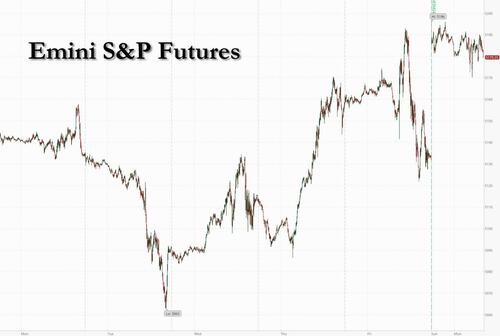












Leave A Comment